
Resource Acknowledgement
The following resource was originally developed for The Open Sanctuary Project as part of Dr. Emily Tronetti’s dissertation project in pursuance of her Doctor of Education (EdD) through Antioch University and the Institute for Humane Education. Emily specializes in adult humane education and applied animal behavior, and is passionate about helping advocates and organizations cultivate compassionate coexistence through teaching about and supporting the agency and wellbeing of other animals. We are so grateful for her collaborative efforts and contributions to The Open Sanctuary Project.
This Resource is Part Five of a Fully-Downloadable Guide!
This resource is the fifth part of a fully-downloadable guide that was originally developed as a comprehensive resource to help sanctuary educators foster and teach about farmed animalA species or specific breed of animal that is raised by humans for the use of their bodies or what comes from their bodies. agency and consent in the context of sanctuary education and outreachAn activity or campaign to share information with the public or a specific group. Typically used in reference to an organization’s efforts to share their mission.. In our efforts to make larger resources like the fully-downloadable guide as accessible as possible in various formats, we broke it down into six individual parts/resources. If you’re interested in reading the sixth part of the original resource, “A Guide to Fostering Farmed Animal Agency in Sanctuary Education: Part Six”, please click here. If you’d like to access the fully-downloadable guide, please click here.
Reflection Questions
Throughout this resource, you will notice questions in boxes like this. To get the most out of this guide, we encourage you to pause and reflect on each question and discuss them with your colleagues. To help with this, please click here for a list of the reflection questions and space for you to share your thoughts.
Tips for Teaching About Agency and Consent
One of the most impactful ways we can foster agency and consent of sanctuary residents, as well as other animals outside of sanctuary settings, is by explicitly teaching our visitors about these concepts and why they’re so important. By doing so, we can inspire guests to imagine and practice new ways of perceiving and interacting with farmed animalsA species or specific breed of animal that is raised by humans for the use of their bodies or what comes from their bodies. on both individual and systemic levels. However, there are a few education-specific challenges we face, such as creating developmentally appropriate content for children and navigating the unique complexities of teaching adults. This section will offer guidance on how to navigate these challenges and will provide insights and ideas for effectively teaching about and promoting farmed animal agency and consent.
Embrace Our Roles as Educators
Often, folks who facilitate educational programs in sanctuary settings don’t bear the official title of “educator” or have formal backgrounds or professional experience in education. Many of the folks who share information about sanctuary residents, animal exploitationExploitation is characterized by the abuse of a position of physical, psychological, emotional, social, or economic vulnerability to obtain agreement from someone (e.g., humans and nonhuman animals) or something (e.g, land and water) that is unable to reasonably refuse an offer or demand. It is also characterized by excessive self gain at the expense of something or someone else’s labor, well-being, and/or existence., and veganismA movement and way of living that seeks to eliminate the exploitation of and cruelty to nonhuman animals as much as possible. Often, veganism is defined synonymously with a plant-based diet, although veganism includes abstaining from elements of animal exploitation in non-food instances when possible and practicable as well. are often those who founded the sanctuary, provide care to the residents, and/or have other roles within the sanctuary. Regardless of title or background, however, folks who facilitate educational programs and participate in these roles in sanctuary settings are indeed educating others about important topics, including farmed animal agency and consent. By embracing our roles as educators, we can feel more empowered to learn how to teach in a way that inspires behavior change, such as changes in how people directly interact with other animals and changes in their dietary choices. To achieve this, we can look to established approaches to education that align with our missions to help guide our practices as sanctuary educators.
One such approach is humane education, which is an educational practice that promotes curiosity, critical thinking, empathy, and compassionate action for a more just and humane world for all beings and the planet (Saari, 2018; Weil, 2016). As we learn from the field of comprehensive humane education, we can consider how to foster these skills and actions in service of supporting the agency and well-being of other animals in sanctuary education and beyond. We’ll discuss this further below and will also consider other ways that various educational theories and practices can shape our work as sanctuary educators.
Know Our Audiences
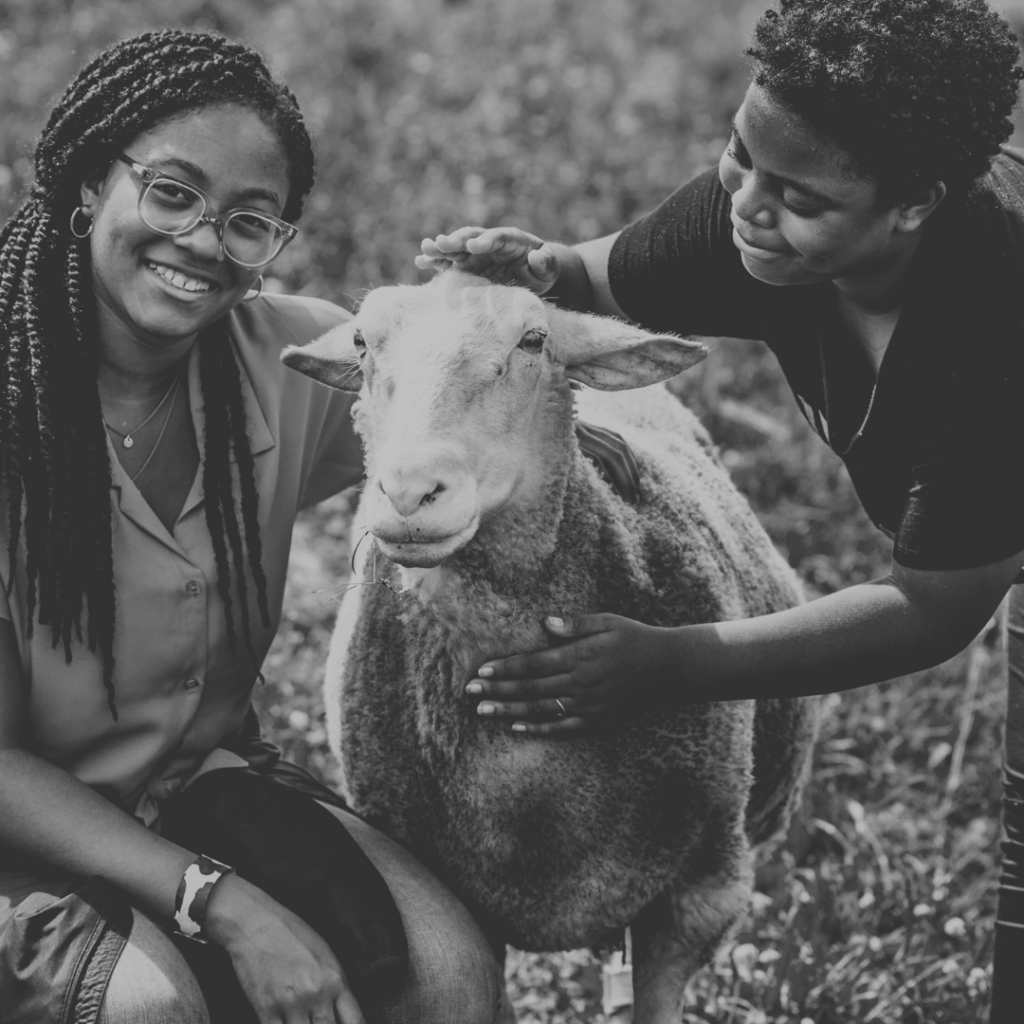
Learning about our audience members is important to our roles as educators as it enables us to tailor our teaching to them (Brookfield, 2012). If our audience includes children, this may mean learning about developmentally appropriate education for the specific ages we’ll be working with. The Open Sanctuary Project has some great resources that sanctuaries can utilize when teaching children of various age groups.
Teaching adults about farmed animals presents its own set of unique considerations for sanctuary educators. For example, it can be helpful to remember that adults have had a lifetime of conditioning by the meat, dairy, and other industries, the media, and more (Joy, 2020). So, a complex and often painful process of unlearning may need to take place. With this in mind, another concept, transformative learning theory, is useful for sanctuary educators. Transformative learning is a process by which we “question our previously held views about ourselves and the world around us” (Cranton, 2016, p. 14). It can be powerful to engage in this process with our adult audiences, which we’ll discuss further soon.
Reflection Questions
Who is your audience? What do you know about them already? What else would be helpful to know about them? What kinds of questions might you ask your audience to nurture a safe and supportive learning space?
In the case of live educational events, such as sanctuary visits, it can be helpful to gather information ahead of time about who will be present, if possible. This helps sanctuary educators customize our educational plans in a way that is informative and engaging while also prioritizing the agency of the residents. When visits are well-thought-out and have a general structure, this can help us better cope with and resist some of the social pressure that may lead to us compromising resident agency. However, respecting the agency and consent of residents also means that we need to be flexible and ready to adapt on the fly. It’s extremely beneficial to build into our plan space and time to improvise based on resident needs and desires as well as any questions visitors may have.
On the topics of time and knowing our audience, it’s also vital to make time for cognitive and emotional processing. This is especially crucial for children but necessary for adults, too. In sanctuary education, we’re often sharing complex information about difficult and sometimes even painful subjects, such as suffering and death. Teaching about farmed animal agency exposes the many awful ways that these animals systematically have their agency denied outside of sanctuary. We have to approach these topics with gentle intentionality, allowing for space and time to digest and process in a supportive and safe environment. We can do this by encouraging dialogue and reflection through explicit verbal exercises or through nonverbal activities such as journaling or drawing.
“It is through the support of others that we have the courage to challenge our own perspectives, assumptions, and beliefs.”
Cranton, 2016, p. 122
As agency-centered sanctuary educators, knowing our audiences helps us identify exercises and other practices that can lead to meaningful, transformative experiences for all visitors while prioritizing the well-being of our residents.
Embrace Transparency and Agency
Transparency in sanctuary settings is essential for many reasons. For the purpose of this resource, it’s important to acknowledge how transparency can serve as a way to model agency-centered practices. Starting with the website, we can set expectations and make it clear that resident agency and consent are prioritized during sanctuary visits and events. We can share our guidelines for how we interact with residents on our website, social media, and in our introductions during visits and events.
We can also go deeper than just stating what our guidelines are. It can be illuminating and impactful to explain to our visitors why things like agency and consent are important to us and what influenced our ways of thinking and the choices we make as sanctuary educators. For example, if we’re incorporating ways for visitors to engage with residents that aren’t focused on touch/close proximity, we can explain why. This models empathy and critical thinking, which we’ll talk more about soon!
Cultivate Empathy
Consider Messaging and Language
In educational contexts such as sanctuaries, language choice can significantly impact perceptions of other animals and our empathy towards them (Young et al., 2018). When referring to residents and the farmed animals who haven’t made it to sanctuary, it’s important to avoid language that reinforces stereotypes or harmful biases about farmed animals. Instead, it can be powerful to use positive language that highlights who they are as individuals. For example, referring to certain individuals, such as roosters, as “dominant” may perpetuate harmful ways of thinking about and treating other animals that suppress their agency. We tend to associate dominance with violence, and when other animals are portrayed as such, it often triggers in us the need to have control over them. On the other hand, terms like “protector” or “guardian” might better promote empathy and compassion towards animals like roosters. Using language that could potentially belittle or infantilize farmed animals might also influence how we view their agency and their ability to consent or not. For example, referring to adult animals as “babies” or “boys/girls” may imply a lack of competence in making their own choices and diminish the significance of their consent or lack thereof (p. jones, 2022).

It can also be helpful to consider the language sanctuaries use to frame our educational programs and how it might impact the agency of the residents. For example, outside of a traditional sanctuary context, the term “tour” is often used to refer to experiences that prioritize entertainment and viewership rather than agency and consent. In response to recent thinking around this, some sanctuaries have transitioned from using the word “tour” to using terms like “guided visit.” Pondering the various ways sanctuary educators can (re)frame our programs opens up the possibility of reconceptualizing sanctuary education and outreach in favor of more agency-centered practices.
Consider Your Sanctuary’s Current Messaging
Consider the language you and your sanctuary currently use and how it might shape perceptions about farmed animals and their agency and well-being.
The way sanctuary educators frame their programs and talk about farmed animals is critical in shaping others’ perceptions of them. By remaining thoughtful and aware of the language used, we can begin to shift attitudes towards farmed animals and foster a greater understanding and appreciation for who they are and why they deserve to live as freely as possible.
Teach About Resident Emotions, Behavior & Well-Being
“The best available knowledge combines an understanding of knowledge about species with knowledge about individuals. CowsWhile "cows" can be defined to refer exclusively to female cattle, at The Open Sanctuary Project we refer to domesticated cattle of all ages and sexes as "cows.", chickens, pigs, turkeysUnless explicitly mentioned, we are referring to domesticated turkey breeds, not wild turkeys, who may have unique needs not covered by this resource., ducksUnless explicitly mentioned, we are referring to domesticated duck breeds, not wild ducks, who may have unique needs not covered by this resource., geeseUnless explicitly mentioned, we are referring to domesticated goose breeds, not wild geese, who may have unique needs not covered by this resource., sheep, and goats possess complex cognitive and emotional inner worlds. They express clear individual preferences, likes, and dislikes. They are curious, loving, affectionate, playful, joyful, and empathetic, and they experience boredom, fear, stress, pain, frustration, loneliness, grief, anxiety, depression, and lasting traumas from the harms and losses they suffer. They form close and enduring bonds with kin and others, reflecting an intense intra- and interspecies sociality, and they have the capacity to resist the conditions that oppress them.”
Gillespie, 2021, p. 7
Teaching about resident emotions, behavior, and well-being can be a powerful approach to deepening empathy and helping our learners understand and value farmed animal agency. One concept that might aid sanctuary educators in appreciating this approach and incorporating it into their daily practice is entangled empathy. Lori Gruen (2015) described this relationship-centered concept in her book Entangled Empathy: An Alternative Ethic for Our Relationships with Animals. Entangled empathy is an emotional and cognitive process requiring that we are “responsive and responsible in [our] relationships by attending to another’s needs, interests, desires, vulnerabilities, hopes, and sensitivities” (Gruen, 2015, p. 10).
Engaging in entangled empathy means resisting our assumptions about what another being is feeling and, instead, taking the time to understand what their perspectives and experiences might actually be like (Gruen, 2015). In this way, entangled empathy also includes recognition and respect for the agency of others (Gruen, 2015). Unfortunately, entangled empathy is often lacking in our relationships with other animals, especially farmed animals, who are typically viewed by society as mere resources for human consumption (Taylor, 2017; Waldau, 2013). However, we can challenge these views by teaching folks about who sanctuary residents are and highlighting how farmed animals are individuals with their own preferences, experiences, and relationships. This lays the groundwork for entangled empathy and recognition of farmed animal agency.
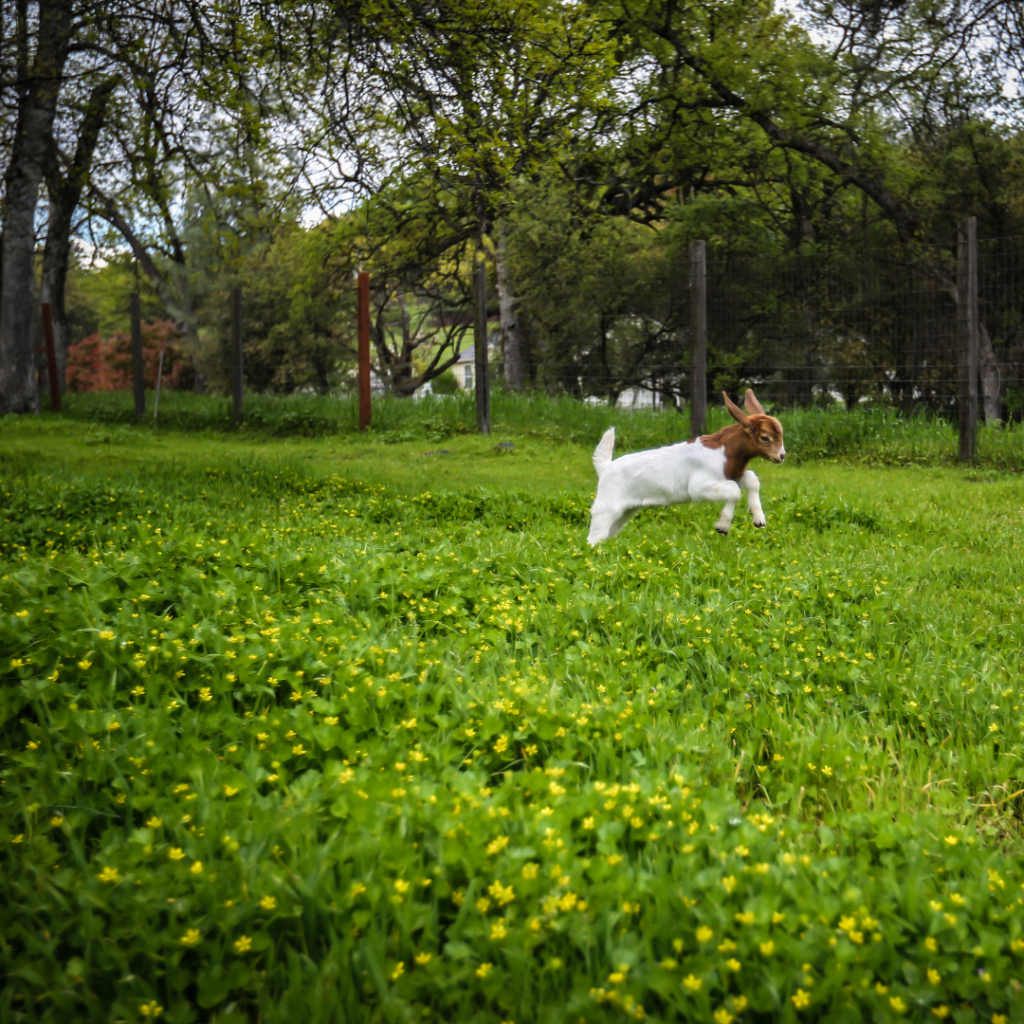
One way we can inspire these different perceptions and relationships with farmed animals is to share their stories (which we’ll talk more about on the next page). Another important part of this is teaching about farmed animal emotions, behavior, and body language. While they’re commonly referred to as “the voiceless,” nonhumans are communicating with us and each other all of the time (jones, 2021; Taylor, 2017, 2021). We can demonstrate this by narrating resident behavior observations and sharing potential interpretations* in real time to build empathy and highlight their agency. For example, we could point out when roosters are sharing food with hens (tidbitting) or when cows are grooming each other (allogrooming). Then, we can discuss how vital the freedom to enact these natural behaviors is to their well-being. Encouraging mindful observation of animal behavior and cultivating entangled empathy can help others see for themselves the importance of agency and consent to other animals.
*It’s crucial to be cautious about the assumptions we make about behavior and acknowledge our limitations in interpreting the behavior and emotions of other species. This also models critical thinking, which we’ll discuss more soon!
“Sanctuaries provide a space for farmed animals to live their lives for no purpose other than their own, and sanctuary volunteers and employees rejoice in seeing those individuals living with as much freedom, wellness, and agency as possible—the embodiment of empathetic joy.”
Brown, 2019, p. 144
Tell Stories!
As previously mentioned, teaching about who animals are is vital to teaching about agency. While describing the emotions and behaviors of farmed animals is important to this, it can also be very impactful to share their stories.
During sanctuary education, it can be tempting to share numerical data that represents the extent to which farmed animals have their agency denied and how they suffer for it. However, it can be very challenging for members of the general public to internalize the magnitude of these numbers and to emotionally connect with facts and figures. To overcome this, we can teach about what happens in the meat and dairy industries, for example, by sharing the stories of the sanctuary’s residents. Sharing their stories is “a wonderful way to illuminate the lived realities, experiences, and perspectives of your sanctuary residents” (Springirth, 2021). We can describe what they experienced prior to sanctuary, such as the ways their agency was denied or suppressed and how their lives are different now. We can share how each resident has evolved since coming to sanctuary, such as how their behaviors and personalities have changed. As sentient beings with the will and desire to shape their own lives, their stories continue to unfold, and sharing this with folks helps them “learn from and with the animals at the sanctuary” (Bentley & Alsop, 2017, p. 72). It can also be powerful to share how your own story intersects with that of the residents. How has your personal relationship with them transformed in the time you’ve known them? How have they changed, and how have they changed you? By sharing our own stories, we may be able to teach and connect with our learners more deeply.
Reflection Questions
How have your sanctuary’s residents changed since coming to sanctuary? How has your personal relationship with them transformed in the time you’ve known them? How have they changed, and how have they changed you?
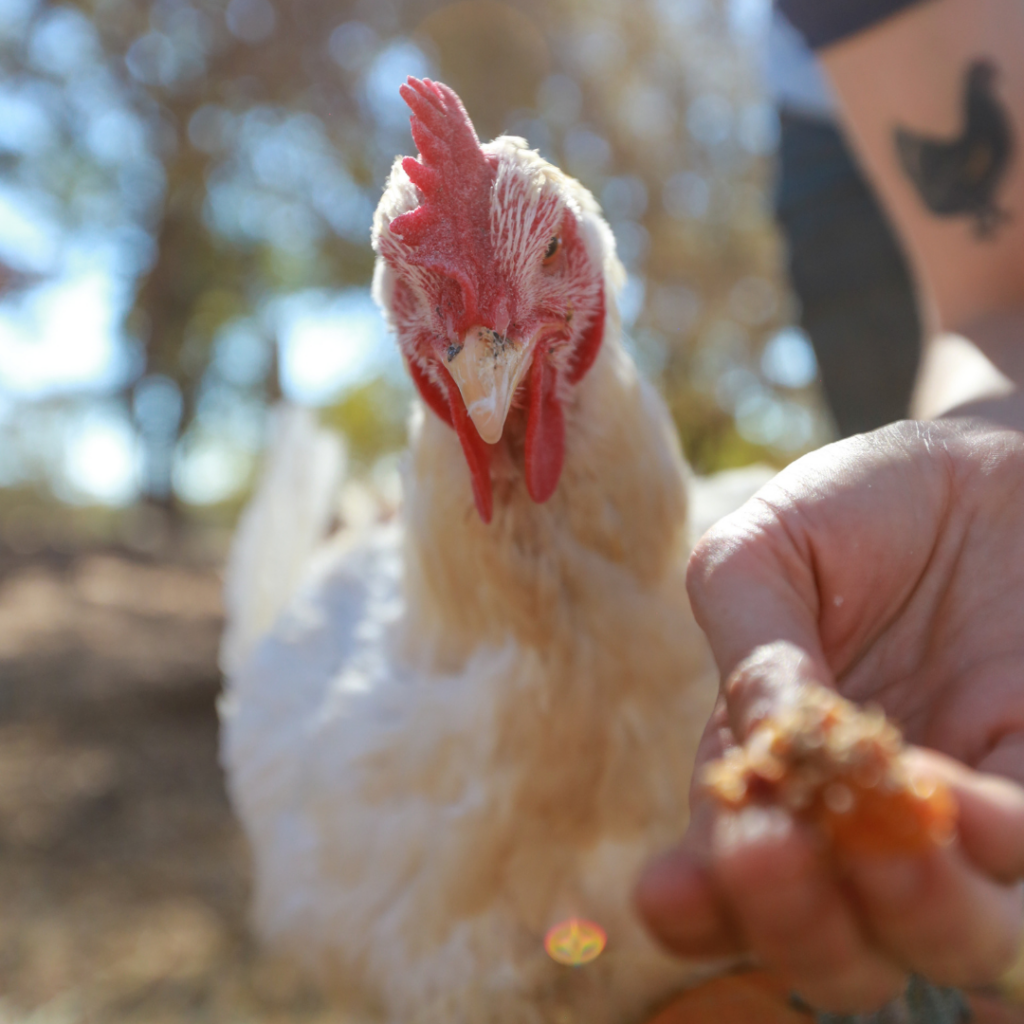
During guided visits, we may not have time to share the stories of every resident. Still, it can be powerful to introduce every animal that visitors can see by name whenever possible. This emphasizes that each resident is an individual who matters to the sanctuary community. However, it’s worth repeating that we have to be careful about the language we use. Word choice is essential when talking to and about other animals. For example, when referencing them, it’s important to avoid the use of the pronoun “it.” When sentient beings are referred to as “it,” it’s easier to objectify them, suppress their agency, and commodify them. Referring to other animals by their names and pronouns like she, he, or they helps us to embrace them as subjects with meaningful inner lives and experiences (Springirth, 2021; Young et al., 2018). It’s also important to reflect on whose stories we choose to tell and why, in addition to reflecting on what the underlying messages of those stories might be.
Reflection Questions
Whose stories do you choose to tell? Are certain species or individuals being left out? What are the underlying messages of the stories you share? What perceptions about farmed animal agency might they promote?
In addition to incorporating storytelling into onsite visits and events at sanctuaries, we can also share resident stories via social media, the sanctuary website, or other forms of online or offsite education. It can be especially powerful to pair resident stories with videos of them. This is an alternative way of sharing stories while respecting the agency and consent of residents who prefer not to interact with unfamiliar humans. We can also talk about this transparently with our viewers to model how the sanctuary is prioritizing resident agency.
Model Empathy & Consent-Informed Interactions
Modeling is another meaningful way that sanctuaries can influence public perceptions of farmed animals. Sanctuaries “model for others ways of living with and relating to [other] animals as subjects” (Abrell, 2021, p. 86). While modeling has come up a few times so far in this resource, this section will highlight how impactful it can be to model empathy through our interactions with both the residents and the visitors. This can inspire visitors to tap into their own empathy for other beings and to remain more open to alternative perspectives on farmed animal agency and well-being.
A powerful way to model empathy with visitors is to acknowledge how challenging it can be to prioritize agency and consent when interacting with other animals. Because of how we’ve been conditioned to view and treat other animals, considering whether or not they consent to interacting with us isn’t intuitive. Rather, it’s a lifelong practice of learning, unlearning, and adjusting our behavior accordingly, even for those of us who work and volunteer at sanctuaries. It can be really beneficial to be transparent about this. It’s also helpful to make it clear that we’re here to meet people where they’re at in this journey and to offer empathy and support. One way we can do this is to recognize their desire to touch and connect with the sanctuary residents while also advocating for seeing things from the residents’ perspectives (S. Bexell, personal communication, April 5, 2023). For example, a stranger coming into our home, let alone one who’s trying to touch us, would be pretty terrifying!
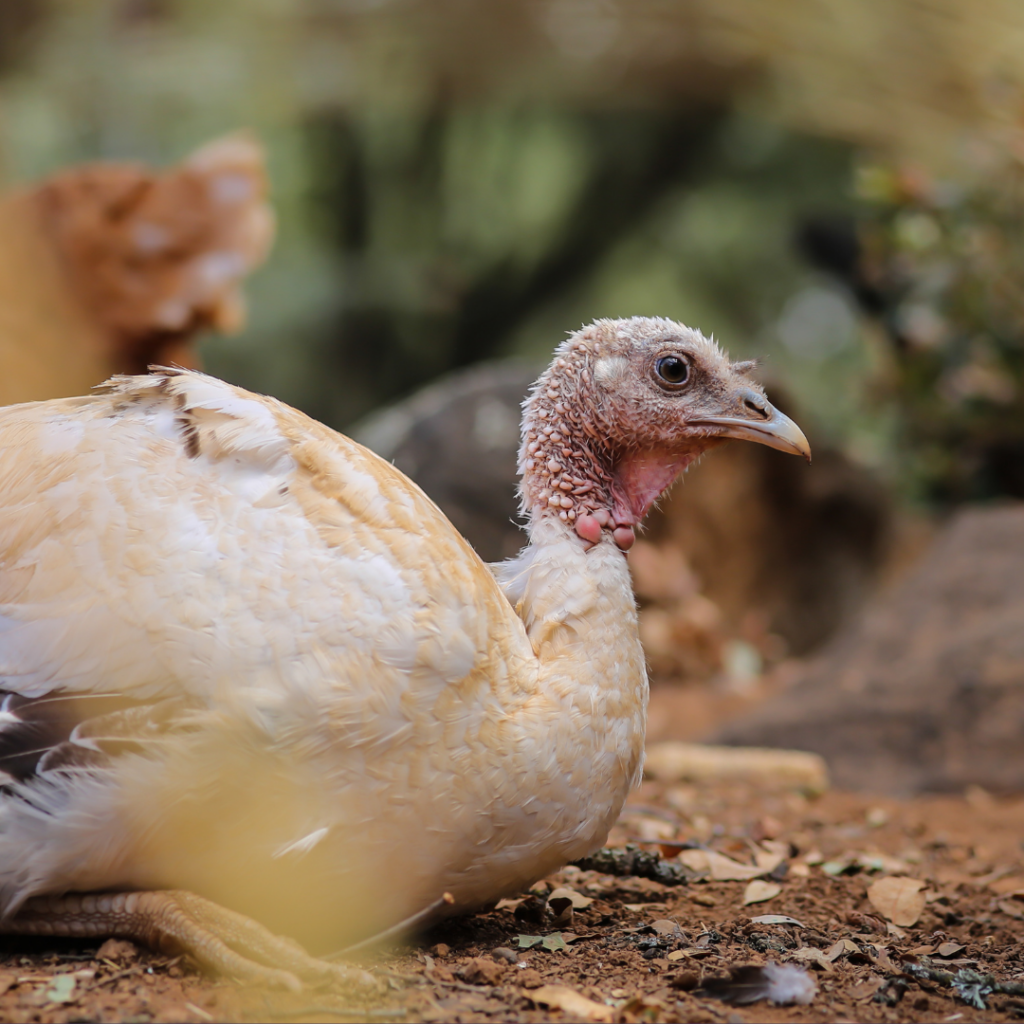
Another way to model empathy with visitors is to show a genuine interest in who they are and what they bring to their time at the sanctuary. We can offer opportunities for visitors to introduce themselves and answer questions throughout the guided visit to build rapport and create a sense of safety and trust. We can model gentle curiosity about others, which could then translate to a gentle curiosity about the residents and an openness to hearing new perspectives.
Modeling is also crucial to consider when interacting with sanctuary residents in the presence of visitors or in videos and photos shared with the public. This means having consent-informed interactions with the residents and minimizing the use of aversive control over them as much as possible. When concern for agency extends beyond sanctuary education to permeate all aspects of the organization’s practices and culture, what we’re teaching becomes all the more salient and powerful.
Build Relationships Without Compromising Agency
One of the most powerful ways we can inspire empathy for farmed animals and concern for their well-being is to provide a space for people to build relationships with them without compromising their agency.
To learn about farmed animal agency in community we need first of all to acknowledge the limited and distorted perspective we bring to this question (as to most questions about animals), and to be cautious, and humble in our claims. Crucially, we need to spend time in community with farmed animals, to learn from them, and to be prepared to respond and adjust our learning process through relationships with them. To understand the relational agency of farmed animals in multispecies society…we need to enter and be part of their world.”
Blattner et al., 2020, p. 5
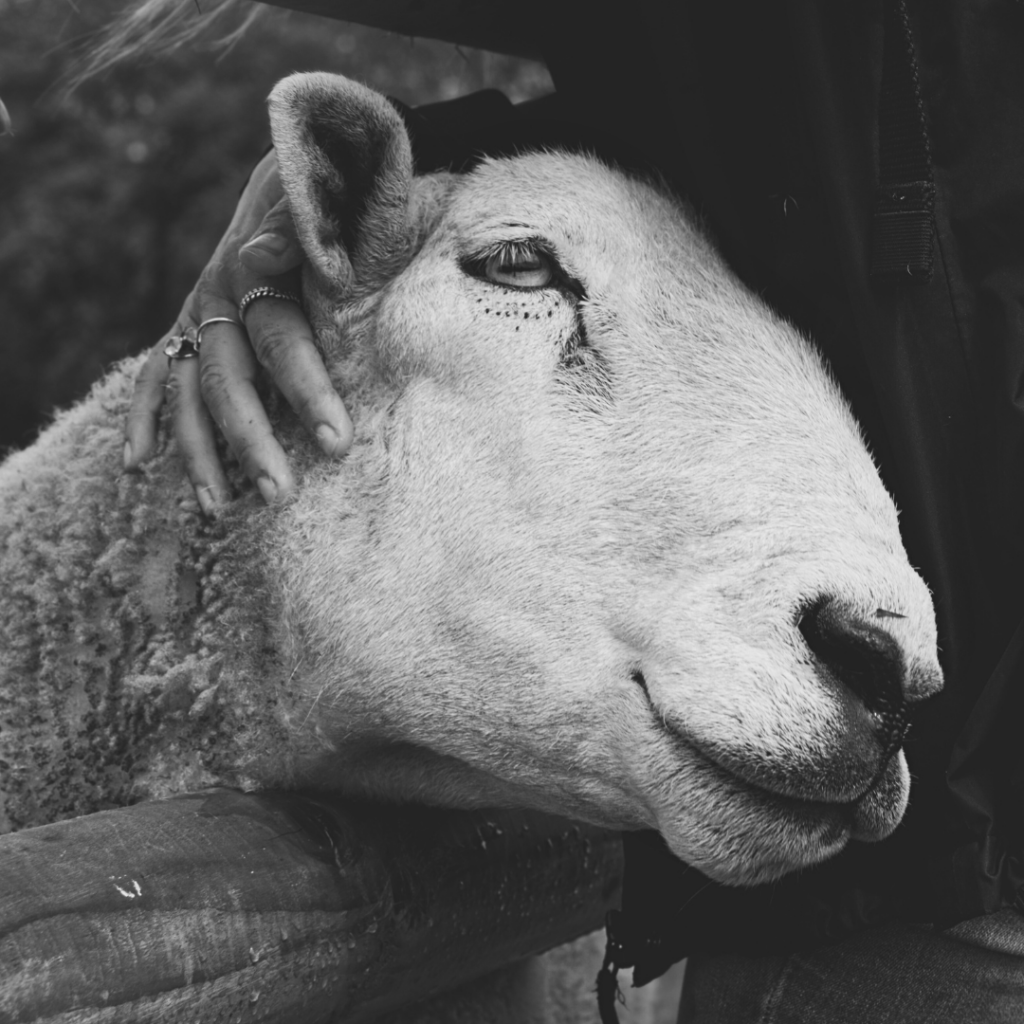
As sanctuary educators, we can guide folks through this process of spending time in community with farmed animals and learning with them (Bentley & Alsop, 2017). We can foster visitors’ empathy for the individual residents and discuss how prioritizing their agency and respecting whether or not they consent to interactions is fundamental to our relationships with them. When we deny or suppress agency, when we ignore non-consent, we diminish trust and reinforce oppressive power dynamics. Centering farmed animal agency is a way to counter this.
We can foster relationships with farmed animals both onsite as well as offsite, such as through videos and pictures shared on social media or in presentations. Virtual field trips are another great option for helping the public connect with farmed animals in a way that might be more considerate of their agency. There are many ways that we can deepen empathy for farmed animals as sanctuary educators. By doing so, we help to inspire folks to be present with other animals and mindful of how we may influence their well-being. This is essential to teaching about their agency and how we can better support it.
Cultivate Mindfulness
While this can be challenging to do for a variety of reasons, slowing down and promoting the practice of being present can be very helpful in teaching about and fostering resident agency. As educators, we can cultivate mindfulness by encouraging observations, creating space for silence and reflection, and asking visitors to engage their other senses (Cranton, 2016; Wergin, 2019). Mindfulness “keeps us alert to both what is going on around us and how we are choosing to interpret that experience” (Wergin, 2019, p. 162). By fostering mindfulness, we can deepen awareness of the environment and its role in shaping not only our own experiences but how the residents may be experiencing the present moment, too. Mindfulness can help us as educators, as well as visitors, really notice what residents are communicating, whether or not they consent to the interaction, and how we may be impacting their well-being. Mindful interactions with other animals can also enhance the visitors’ and our own well-being and reduce stress, which can promote a more relaxed and enjoyable experience for all (Paul et al., 2023). And when visitors aren’t able to interact with the residents, promoting mindfulness may help them still have a meaningful sanctuary experience.
Additionally, mindfulness helps create the conditions necessary for critical thinking and curiosity (Wergin, 2019). It can foster openness to new perspectives and can create space for visitors to engage in meaningful conversations as they reflect on what they’re learning at the sanctuary. In the next section, we’ll explore more deeply the role of critical thinking and curiosity in agency-centered education.
Cultivate Critical Thinking and Curiosity
Cultivating skills like critical thinking and curiosity in our visitors, supporters, and community members can be fundamental prerequisites for centering farmed animal agency and promoting their well-being. By encouraging critical thinking, we can help individuals question and challenge societal norms, the ways that farmed animals traditionally have their agency denied, and the suffering that results from this. Additionally, fostering curiosity can spark a desire to learn more about farmed animals, their complex emotional and social lives, and their unique needs. This could lead to greater empathy and a willingness to advocate for farmed animal agency and well-being.
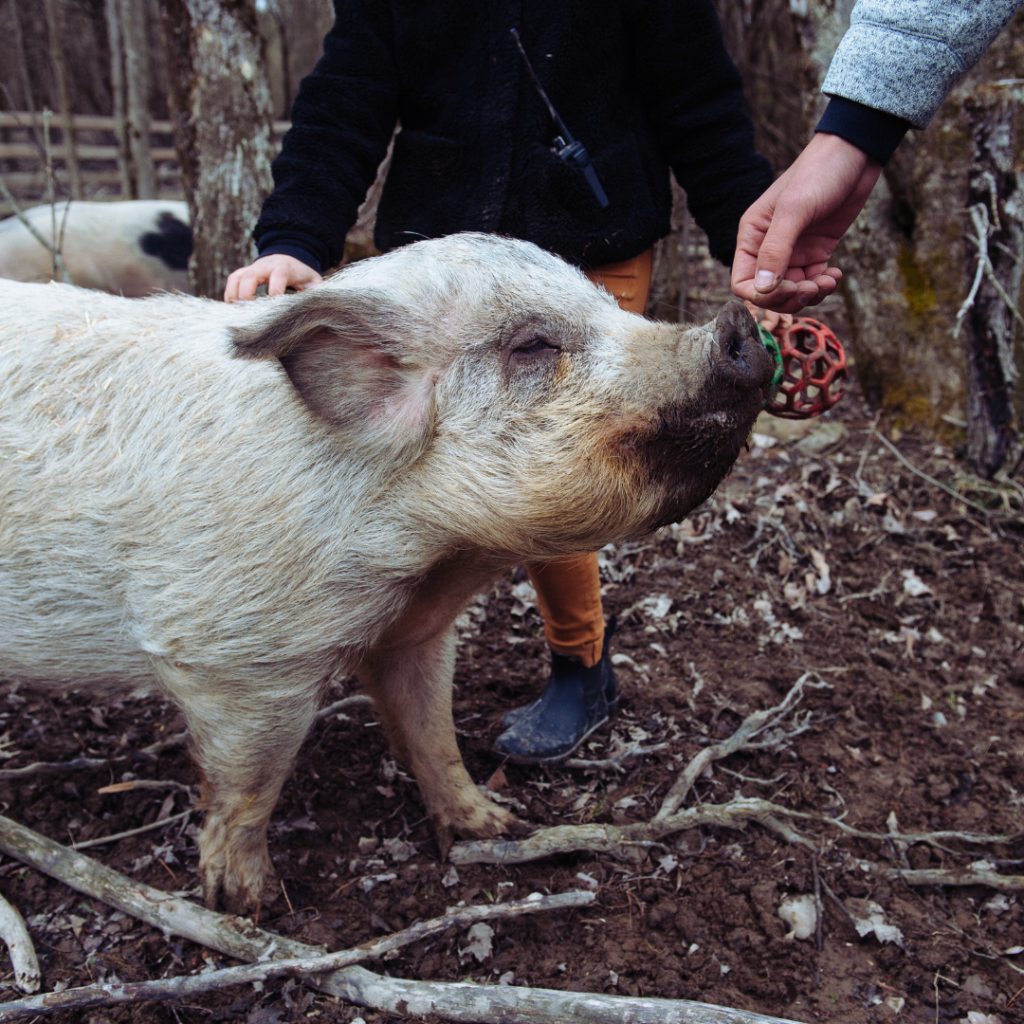
On the topic of critical thinking, it’s important to revisit how much being aware of and intentional in our messaging and language matters. As educators, it’s also crucial to practice critical thinking and reflect on the power of the words we use and the activities we choose. We can have an immense impact on the perceptions and behaviors of others, and a continuous practice of critical reflection can help ensure that our approach has the intended outcomes (Brookfield, 2012).
As part of an ongoing process of critical reflection, some helpful questions sanctuary educators can consider asking themselves include:
- How could this practice impact the residents?
- How might this practice make the residents feel?
- What messages might it send to visitors?
It can be especially helpful to share our own critical reflection processes with visitors and our other learners. Modeling critical thinking encourages learners to do the same (Brookfield, 2012). We can share our own journey in questioning our assumptions and beliefs about farmed animal agency and well-being. We can talk about how our openness to other perspectives and new information has changed us and how we interact with farmed animals. This allows others to see the process of critical thinking in action which can encourage them to reflect on their own beliefs and assumptions and to consider new ways of being. We can also be transparent about how this is a daily practice and how we might still catch ourselves slipping back into old ways of thinking about other animals. It can be especially impactful to acknowledge these slip-ups in real time. For example, we might start to touch a resident without first checking in with their body language to ensure they’re consenting to the interaction. This level of transparency helps others feel less alone and establishes a supportive space to embark on their own critical thinking journeys.
Reflection Questions
What biases and assumptions have you had in the past about farmed animals? What might you still be holding on to? Do you have any biases about the sanctuary’s residents? About its visitors? About your community? How might these biases and assumptions impact your approach to sanctuary education?
Stay Connected
When it comes to teaching about agency and consent during sanctuary education, it can be beneficial to provide ways for people to stay engaged and connected with us as educators, the sanctuary, and most importantly, the residents. As we’ve explored in this resource, concepts like agency and consent in the context of other animals can be hard for humans to grasp and embody. This is especially the case if they’re only exposed to it during an hour-long visit at the sanctuary. Visitors, supporters, and other community members need time to process and reflect, as well as repeated exposure to these concepts, for them to really hit home and sink in.
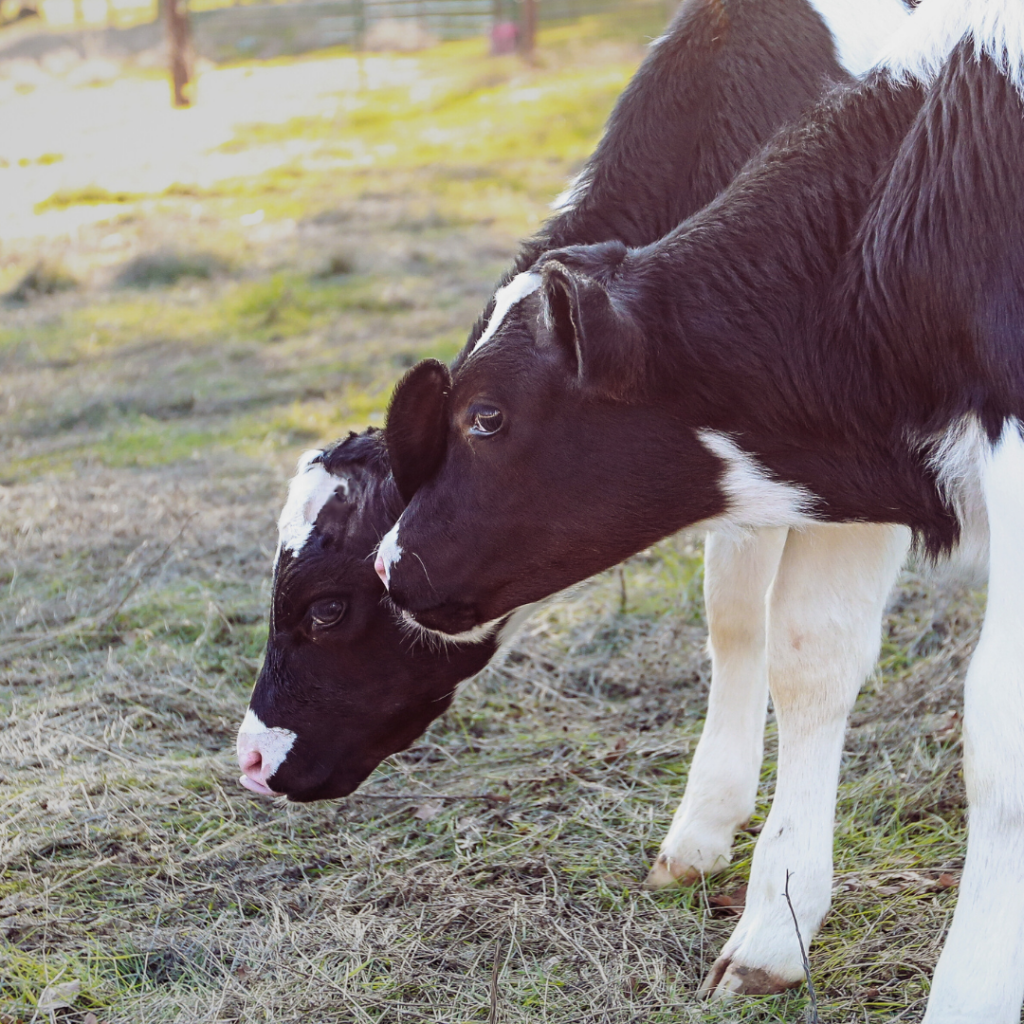
Reflection Questions
In what ways can you facilitate and support people in staying connected to the sanctuary and to each other?
Sanctuaries can maximize their impact by providing additional opportunities for education and engagement beyond the standard guided visit. This can be done through hosting classes, workshops, or other types of in-person and online events to help people continue to deepen their understanding and appreciation for farmed animal agency and well-being. Many sanctuaries might also benefit from encouraging more volunteers by offering volunteer days or other options to make volunteering more accessible to the public and easier to manage for the sanctuary.
These opportunities allow for a more interactive and immersive experience with the sanctuary, in addition to creating more space for folks to ask questions, engage in discussions, and learn from each other. This can help prepare folks to advocate for farmed animals in their daily lives and to transcend simply being sanctuary visitors to becoming members of the sanctuary community. Overall, approaches to sanctuary education that promote ongoing engagement with the sanctuary can help to create more meaningful and impactful relationships between members of the public, the sanctuary, and its residents.
Interested in Learning More?
Interested in learning more about fostering farmed animal agency and consent in sanctuary education? Please click here to read the sixth and final part of this guide as a standalone resource!
We’d Love to Hear from You!
This guide is a living document that we plan to make continual changes to as we get feedback from sanctuary staff and volunteers who have implemented what they’ve learned from this guide into their sanctuary education practices. In our efforts to ensure this guide is as helpful as possible to sanctuary staff, volunteers, visitors, supporters, and, most importantly, the residents, we’d love to hear how this guide has impacted your work. If you have feedback, please contact us here!
Sources
A Guide to Fostering Farmed Animal Agency in Sanctuary Education | The Open Sanctuary Project
Communicating with Youth About Animal Exploitation | The Open Sanctuary Project
The Significance of Humane Education in a Sanctuary Setting | The Open Sanctuary Project
Fostering Critical Thinking at Your Animal Sanctuary | The Open Sanctuary Project
Fostering Empathy Towards Farmed Animals | The Open Sanctuary Project
Strategic Planning for Educational Programming at Your Animal Sanctuary | The Open Sanctuary Project
All About Social Media for Your Animal Sanctuary | The Open Sanctuary Project
The Importance of Language Choices at Your Animal Sanctuary | The Open Sanctuary Project
Introduction to Rooster Behavior Part One: Dismantling Rooster Stigma | The Open Sanctuary Project
Observation: An Important Caregiving Tool | The Open Sanctuary Project
In-Person Sanctuary Educational Programming: What Are Your Options? | The Open Sanctuary Project
Effective Website Elements for Your Animal Sanctuary | The Open Sanctuary
Virtual Sanctuary Educational Programming: What Are Your Options? | The Open Sanctuary Project
The World Becomes What We Teach: Educating a Generation of Solutionaries | Zoe Weil
Why We Love Dogs, Eat Pigs, and Wear Cows: An Introduction to Carnism | Melanie Joy
Confronting Our Own Speciesism | pattrice jones
Entangled Empathy: An Alternative Ethic for Our Relationships with Animals | Lori Gruen
Beasts of Burden: Animal and Disability Liberation | Sunaura Taylor
Animal Studies: An Introduction | Paul Waldau
Eros and the Mechanisms of Eco-defense | pattrice jones
Saving Animals: Multispecies Ecologies of Rescue and Care | Elan Abrell








